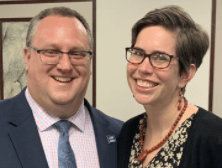The Challenge: Drug-Resistant Epilepsy
When Merissa Fitzpatrick talks, her voice resonates with optimism. But the 38-year-old Pittsburgh resident says that wasn’t always so.
"I questioned whether I would ever get better. But once I met with Dr. Viji, the ball started rolling...fast!" — Merissa
In 2013, tired after a long day at work as a food development lab technician, she sat down on the couch and asked her husband, “Do you ever see double?” Before he could respond, Merissa had her first grand mal epileptic seizure. She woke up in the hospital three days later.
At the time, the couple lived with their three young children in Ellwood City, north of Pittsburgh. Merissa began seeing a neurologist who prescribed increasing dosages of a common antiseizure medication.
“I didn’t react well to that drug,” recalls Merissa. “But my kids were little, I was working full-time, and life was crazy. So I convinced myself to take the pill to deal with things — even though the pill was making my life unbearable.”
She eventually tried several other medications without success.
Schedule an Appointment or Ask a Question
When the family moved to Pittsburgh a few years later, she met with Kelly Kay, MD, chief of neurology at UPMC East. By then, Merissa was having weekly seizures — plus excruciating migraine headaches. Dr. Kay arranged for Merissa to meet Vijayalakshmi (Viji) Rajasekaran, MD, an epileptologist (epilepsy specialist), at the UPMC Comprehensive Epilepsy Center..
"I remember being so grateful to Dr. Kay for recognizing that what I had wasn’t normal,” says Merissa. “At that point, I questioned whether I would ever get better. But once I met with Dr. Viji, the ball started rolling...fast!"
The Solution: sEEG, Ablation, and Craniotomy
To determine the nature and extent of her epilepsy, Merissa had around-the-clock electroencephalography (EEG) testing at the center’s epilepsy monitoring unit (EMU). In the EMU, experts can safely observe and record a patient’s movements, behavior, and brain activity during a seizure.
Merissa then had a stereoelectroencephalography (also called a stereo-EEG or sEEG). This minimally invasive procedure lets doctors pinpoint the exact location of a seizure.
“I was told that an EEG gives surgeons the neighborhood, but an sEEG gives them the exact address of where the seizure lives in the brain,” says Merissa. “With that information, they could do an ablation and ‘zap the house,’ so to speak.”
In April 2019, Merissa had a minimally invasive laser ablation, which uses focused heat to destroy brain tissue causing seizures.
“The ablation and a new medicine completely took care of my migraines, which was phenomenal,” says Merissa. “I was seizure-free for about six weeks, too — but then they kicked back up.”
Merissa’s seizures steadily worsened in frequency and intensity. She decided to undergo a craniotomy, with the goal of removing the portion of her brain causing the seizures. Because the surgery involved the occipital region of the brain, she was advised she could lose her sight.
“A craniotomy definitely has risks, so it’s something of a last resort. But I had already lost almost a decade of my life to epilepsy,” says Merissa. “It forced my husband and kids to carve out a separate little life that I couldn’t be part of because my seizures left me mentally and physically exhausted. I didn’t want epilepsy to take the next 10 years from me and my family.”
The Results: Seizure Freedom
In April 2020, neurosurgeon Jorge Gonzalez-Martinez, MD, PhD, co-director of the UPMC Comprehensive Epilepsy Center and director of epilepsy and movement disorders surgery at UPMC, performed Merissa’s craniotomy.
“Dr. Gonzalez-Martinez was so helpful and respectful as he prepared me for the operation. I felt like I could fully trust him with my care. I can’t speak highly enough about him and everyone at the center who has helped care for me since I first walked in its doors,” says Merissa.
“When I woke up from surgery, all I could think was ‘I can see!’. I do have peripheral vision loss in my left eye, but my brain is already learning to compensate for that,” she says. “Since my surgery, it’s been smooth sailing. I’ve had no seizures. Best of all, my husband tells me I’m more myself and fun to be around. For so long, I was a dulled version of the person I used to be. It feels great to start this new chapter in my life.”
Our patient stories profile a number of patients who have had minimally invasive brain surgery at UPMC. Although everyone's care experience is unique, we hope that sharing these stories will help other prospective patients and their families better understand these procedures and their potential benefits.
Merissa’s treatment and results may not be representative of all similar cases.

















